
- Chess World Cup
- FIDE Grand Prix
- Olympiad
- World Championship
- List of strong tournaments
- List of world championships

- Checkmate patterns
- Chess openings
- Chess strategy
- Chess tactics
- Chess theory
- Endgames
- Pawn structure
- Problems/Compositions












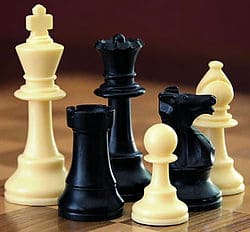 Staunton style chess pieces. Left to right: king, rook, queen, pawn, knight, bishop
Staunton style chess pieces. Left to right: king, rook, queen, pawn, knight, bishop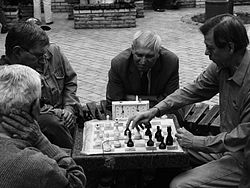 A game in a public park in Kiev, using a chess clock
A game in a public park in Kiev, using a chess clockThe rules of chess (also known as the laws of chess) are rules governing the play of the game of chess. While the exact origins of chess are unclear, modern rules first took form during the Middle Ages. The rules continued to be slightly modified until the early 19th century, when they reached essentially their current form. The rules also varied somewhat from place to place. Today chess's international governing body FIDE (Fédération Internationale des Échecs) sets the standard rules, with slight modifications made by some national organizations for their own purposes. There are variations of the rules for fast chess, correspondence chess, online chess, and chess variants.
Chess is a game played by two people on a chessboard, with sixteen pieces (of six types) for each player. Each type of piece moves in a distinct way. The goal of the game is to checkmate, that is, to threaten the opponent's king with inevitable capture. Games do not necessarily end with checkmate - players often resign if they believe they will lose. In addition, there are several ways that a game can end in a draw.
Besides the basic movement of the pieces, rules also govern the equipment used, the time control, the conduct and ethics of players, accommodations for physically challenged players, the recording of moves using chess notation, as well as provide procedures for resolving irregularities which can occur during a game.
| a | b | c | d | e | f | g | h | ||
| 8 |

                                |
8 | |||||||
| 7 | 7 | ||||||||
| 6 | 6 | ||||||||
| 5 | 5 | ||||||||
| 4 | 4 | ||||||||
| 3 | 3 | ||||||||
| 2 | 2 | ||||||||
| 1 | 1 | ||||||||
| a | b | c | d | e | f | g | h | ||
Chess is played on a chessboard, a square board divided into 64 squares (eight-by-eight) of alternating color, which is similar to that used in draughts (checkers) (FIDE 2008). No matter what the actual colors of the board, the lighter-colored squares are called "light" or "white", and the darker-colored squares are called "dark" or "black". Sixteen "white" and sixteen "black" pieces are placed on the board at the beginning of the game. The board is placed so that a white square is in each player's near-right corner. Horizontal rows are called ranks and vertical rows are called files.
Each player controls sixteen pieces:
| Piece | King | Queen | Rook | Bishop | Knight | Pawn |
|---|---|---|---|---|---|---|
| Number | 1 | 1 | 2 | 2 | 2 | 8 |
| Symbols |   |
  |
  |
  |
  |
  |
At the beginning of the game, the pieces are arranged as shown in the diagram: for each side one king, one queen, two rooks, two bishops, two knights, and eight pawns. The pieces are placed, one on a square, as follows:
Popular mnemonics used to remember the setup are "queen on her own color" and "white on right". The latter refers to setting up the board so that the square closest to each player's right is white (Schiller 2003:16-17).
The player controlling the white pieces is named "White"; the player controlling the black pieces is named "Black". White moves first, then players alternate moves. Making a move is required; it is not legal to skip a move, even when having to move is detrimental. Play continues until a king is checkmated, a player resigns, or a draw is declared, as explained below. In addition, if the game is being played under a time control players who exceed their time limit lose the game.
The official chess rules do not include a procedure for determining who plays White. Instead, this decision is left open to tournament-specific rules (e.g. a Swiss system tournament or Round-robin tournament) or, in the case of non-competitive play, mutual agreement, in which case some kind of random choice is often employed. A common method is for one player to conceal a piece (usually a pawn) of each color in either hand; the other player chooses a hand to open and reveal their color. Play then commences with white.
Each type of chess piece has its own method of movement. A piece moves to a vacant square except when capturing an opponent's piece.
Except for any move of the knight and castling, pieces cannot jump over other pieces. A piece is captured (or taken) when an attacking enemy piece replaces it on its square (en passant is the only exception). The captured piece is thereby permanently removed from the game. The king can be put in check but cannot be captured (see below).
Read main article: Castling
Castling consists of moving the king two squares towards a rook, then placing the rook on the other side of the king, adjacent to it. Castling is only permissible if all of the following conditions hold:
Read main article: En passant
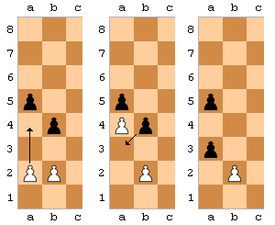
When a pawn advances two squares from its original square and ends the turn adjacent to a pawn of the opponent's on the same rank, it may be captured by that pawn of the opponent's, as if it had moved only one square forward. This capture is only legal on the opponent's next move immediately following the first pawn's advance. The diagrams on the right demonstrate an instance of this: if the white pawn moves from a2 to a4, the black pawn on b4 can capture it en passant, moving from b4 to a3 while the white pawn on a4 is removed from the board.
Read main article: Promotion (chess)
If a player advances a pawn to its eighth rank, the pawn is then promoted (converted) to a queen, rook, bishop, or knight of the same color at the choice of the player (a queen is usually chosen). The choice is not limited to previously captured pieces. Hence it is theoretically possible for a player to have up to nine queens or up to ten rooks, bishops, or knights if all of their pawns are promoted. If the desired piece is not available, the player should call the arbiter to provide the piece (Schiller 2003:17-19).
| a | b | c | d | e | f | g | h | ||
| 8 |

     |
8 | |||||||
| 7 | 7 | ||||||||
| 6 | 6 | ||||||||
| 5 | 5 | ||||||||
| 4 | 4 | ||||||||
| 3 | 3 | ||||||||
| 2 | 2 | ||||||||
| 1 | 1 | ||||||||
| a | b | c | d | e | f | g | h | ||
Read main article: Check (chess)
A king is in check when it is under attack by at least one enemy piece. A piece unable to move because it would place its own king in check (it is pinned against its own king) may still deliver check to the opposing player.
A player may not make any move which places or leaves his king in check. The possible ways to get out of check are:
If it is not possible to get out of check, the king is checkmated and the game is over (see the next section).
In informal games, it is customary to announce "check" when making a move that puts the opponent's king in check. However, in formal competitions check is rarely announced (Just 2014).
These rules apply to games played "over the board". There are special rules for correspondence chess, blitz chess, computer chess, and for handicapped players.
The movement of pieces is to be done with one hand. Once the hand is taken off a piece after moving it, the move cannot be retracted unless the move is illegal. When castling, the player should first move the king with one hand and then move the rook with the same hand (Schiller 2003:19-20).
In the case of a pawn promotion, if the player releases the pawn on the eighth rank, the player must promote the pawn. After the pawn has moved, the player may touch any piece not on the board and the promotion is not finalized until the new piece is released on the promotion square (Just 2014).
Read main article: Touch-move rule
In serious play, if a player having the move touches a piece as if having the intention of moving it, then the player must move it if it can be legally moved. So long as the hand has not left the piece on a new square, any legal move can be made with the piece. If a player touches one of the opponent's pieces then that piece must be captured if there is a legal move that does so. If none of the touched pieces can be moved or captured there is no penalty (Schiller 2003:19-20).
When castling, the king must be the first piece touched. If the player touches the rook at the same time as touching the king, the player must castle with that rook if it is legal to do so. If the player completes a two-square king move without touching a rook, the player must move the correct rook accordingly if castling in that direction is legal. If a player starts to castle illegally, another legal king move must be made if possible, including castling with the other rook (Schiller 2003:20).
If a player moves a pawn to its eighth rank, it cannot be substituted for a different move of the pawn when the player has stopped touching it. However, the move is not complete until the promoted piece is released on that square.
If a player wishes to touch a piece with the intention of adjusting its position on a square, the player must first alert the opponent of this intention by saying J'adoube or "I adjust". Once the game has started, only the player with the move may touch the pieces on the board (Schiller 2003:19-20).
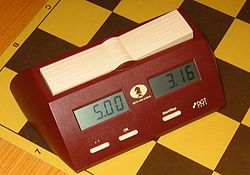 Digital game clock
Digital game clockTournament games are played under time constraints, called time controls, using a game clock. Each player must make his moves within the time control or forfeit the game. There are different types of time controls. In some cases each player will have a certain amount of time to make a certain number of moves. In other cases each player will have a limited amount of time to make all of his moves. Also, the player may gain a small amount of additional time for each move made, either by a small increment added for each move made, or by the clock delaying a small amount of time each time it is started after the opponent's move (Schiller 2003:21-24).
The United States Chess Federation (USCF) rule is different. USCF Rule 14E defines "insufficient material to win on time", that is lone king, king plus knight, king plus bishop, and king plus two knights opposed by no pawns, and there is no forced win in the final position. Hence to win on time with this material, the USCF rule requires that a win can be forced from that position, while the FIDE rule merely requires a win to be possible. (See Monika Soćko rules appeal in 2008 and Women's World Chess Championship 2008 for a famous instance of this rule.)
If a player believes that his opponent is attempting to win the game on time and not by normal means (i.e. checkmate), if it is a sudden death time control and the player has less than two minutes remaining, the player may stop the clocks and claim a draw with the arbiter. The arbiter may declare the game a draw or postpone the decision and allot the opponent two extra minutes (Schiller 2003:21-24,29).
Read main articles: Chess notation and Algebraic chess notation
 Naming the squares in algebraic notation
Naming the squares in algebraic notation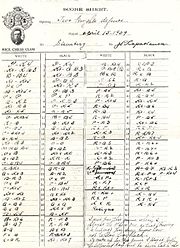 A scoresheet from a game by Capablanca, in descriptive notation
A scoresheet from a game by Capablanca, in descriptive notationEach square of the chessboard is identified with a unique pair of a letter and a number. The vertical files are labeled a through h, from White's left (i.e. the queenside) to White's right. Similarly, the horizontal ranks are numbered from 1 to 8, starting from the one nearest White's side of the board. Each square of the board, then, is uniquely identified by its file letter and rank number. The white king, for example, starts the game on square e1. The black knight on b8 can move to a6 or c6.
In formal competition, each player is obliged to record each move as it is played in a chess notation in order to settle disputes about illegal positions, overstepping time control, and making claims of draws by the fifty-move rule or repetition of position. Algebraic chess notation is the accepted standard for recording games today. There are other systems such as ICCF numeric notation for international correspondence chess and the obsolete descriptive chess notation. The current rule is that a move must be made on the board before it is written on paper or recorded with an electronic device.
Both players should indicate offers of a draw by writing "=" at that move on their scoresheet (Schiller 2003:27). Notations about the time on the clocks can be made. If a player has less than five minutes left to complete all of their moves, they are not required to record the moves (unless a delay of at least thirty seconds per move is being used). The scoresheet must be made available to the arbiter at all times. A player may respond to an opponent's move before writing it down (Schiller 2003:25-26).
A player who makes an illegal move must retract that move and make a legal move. That move must be made with the same piece if possible, because the touch-move rule applies. If the illegal move was an attempt to castle, the touch-move rule applies to the king but not to the rook. The arbiter should adjust the time on the clock according to the best evidence. If the mistake is only noticed later on, the game should be restarted from the position in which the error occurred (Schiller 2003:24-25). Some regional organizations have different rules.
If blitz chess is being played (in which both players have a small, limited time, e.g. five minutes) the rule varies. A player may correct an illegal move if the player has not pressed their clock. If a player has pressed their clock, the opponent may claim a win if he or she hasn't moved. If the opponent moves, the illegal move is accepted and without penalty (Schiller 2003:77).
According to the FIDE Laws of Chess, the first completed illegal move is penalized by awarding the opponent two additional minutes on the clock. The second completed illegal move by the same player results in the loss of the game, unless the position is such that it is impossible for the opponent to win by any series of legal moves (e.g. if the opponent has a bare king) in which case the game is drawn. A move is completed when it has been made and the player has pressed the clock. In rapid chess and blitz chess, the first completed illegal move results in a loss.
If it is discovered during the game that the starting position was incorrect, the game is restarted. If it is discovered during the game that the board is oriented incorrectly, the game is continued with the pieces transferred to a correctly oriented board. If the game starts with the colors of the pieces reversed, the game continues (unless the arbiter rules otherwise) (Schiller 2003:24). Some regional organizations have different rules.
If a player knocks over pieces, it is their responsibility to restore them to their correct position on their time. If it is discovered that an illegal move has been made, or that pieces have been displaced, the game is restored to the position before the irregularity. If that position cannot be determined, the game is restored to the last known correct position (Schiller 2003:24-25).
Players may not use any notes, outside sources of information (including computers), or advice from other people. Analysis on another board is not permitted. Scoresheets are to record objective facts about the game only, such as time on the clock or draw offers. Players may not leave the competition area without permission of the arbiter (Schiller 2003:30-31).
High standards of etiquette and ethics are expected. Players should shake hands before and after the game. Generally a player should not speak during the game, except to offer a draw, resign, or to call attention to an irregularity. An announcement of "check" is made in amateur games but should not be used in officially sanctioned games. A player may not distract or annoy another player by any means, including repeatedly offering a draw (Schiller 2003:30-31,49-52).
Read main articles: Chess piece, Chessboard, Staunton chess set and Game clock
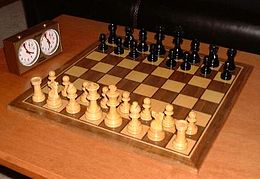 Pieces at the start of a game and an analog chess clock
Pieces at the start of a game and an analog chess clockThe size of the squares of the chessboard should be approximately 1.25 to 1.3 times the diameter of the base of the king, or 50 to 65 mm. Squares of approximately 57 mm (2 1⁄4 inches) normally are well-suited for pieces with the kings in the preferred size range. The darker squares are usually brown or green and the lighter squares are off-white or buff.
 Original Staunton chess pieces, introduced in 1849. Left to right: pawn, rook, knight, bishop, queen, and king
Original Staunton chess pieces, introduced in 1849. Left to right: pawn, rook, knight, bishop, queen, and kingPieces of the Staunton chess set design are the standard and are usually made of wood or plastic. They are often black and white; other colors may be used (like a dark wood or even red for the dark pieces) but they would still be called the "white" and "black" pieces (see White and Black in chess). The height of the king should be 85 to 105 millimetres (3.35-4.13 inches). A height of approximately 95 to 102 mm (3 3⁄4-4 inches) is preferred by most players. The diameter of the king should be 40 to 50% of its height. The size of the other pieces should be in proportion to the king. The pieces should be well balanced (Just 2014).
In games subject to time control, a game clock is used, consisting of two adjacent clocks and buttons to stop one clock while starting the other, such that the two component clocks never run simultaneously. The clock can be analog or digital. Before the start of the game the arbiter decides where the chess clock is placed.
Read main article: Checkmate
| a | b | c | d | e | f | g | h | ||
| 8 |
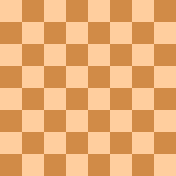
       |
8 | |||||||
| 7 | 7 | ||||||||
| 6 | 6 | ||||||||
| 5 | 5 | ||||||||
| 4 | 4 | ||||||||
| 3 | 3 | ||||||||
| 2 | 2 | ||||||||
| 1 | 1 | ||||||||
| a | b | c | d | e | f | g | h | ||
If a player's king is placed in check and there is no legal move that player can make to escape check, then the king is said to be checkmated, the game ends, and that player loses (Schiller 2003:20-21). Unlike other pieces, the king is never actually captured or removed from the board because checkmate ends the game (Burgess 2009:502).
The diagram shows an example checkmate position. The white king is threatened by the black queen; the square to which the king could move is also threatened; it cannot capture the queen, because it would then be in check by the rook.
Either player may resign at any time and their opponent wins the game. This normally happens when the player believes he or she is very likely to lose the game. A player may resign by saying it verbally or by indicating it on their scoresheet in any of three ways: (1) by writing "resigns", (2) by circling the result of the game, or (3) by writing "1-0" if Black resigns or "0-1" if White resigns (Schiller 2003:21). Tipping over the king also indicates resignation, but it is not frequently used (and should be distinguished from accidentally knocking the king over). Stopping both clocks is not an indication of resigning, since clocks can be stopped to call the arbiter. An offer of a handshake is not necessarily a resignation either, since one player could think they are agreeing to a draw (Just 2014).
Read main article: Draw (chess)
| a | b | c | d | e | f | g | h | ||
| 8 |

    |
8 | |||||||
| 7 | 7 | ||||||||
| 6 | 6 | ||||||||
| 5 | 5 | ||||||||
| 4 | 4 | ||||||||
| 3 | 3 | ||||||||
| 2 | 2 | ||||||||
| 1 | 1 | ||||||||
| a | b | c | d | e | f | g | h | ||
The game ends in a draw if any of these conditions occur:
The player having the move may claim a draw by declaring that one of the following conditions exists, or by declaring an intention to make a move which will bring about one of these conditions:
If the claim is proven true, the game is drawn (Schiller 2003:21,26-28).
At one time, if a player was able to check the opposing king continually (perpetual check) and the player indicated their intention to do so, the game was drawn. This rule is no longer in effect; however, players will usually agree to a draw in such a situation, since either the rule on threefold repetition or the fifty-move rule will eventually be applicable (Staunton 1847:21-22), (Reinfeld 1954:175).
Read main article: Time control
A game played under time control will end as a loss for a player who uses up all of their allotted time, unless the opponent cannot possibly checkmate him (see the Timing section above). There are different types of time control. Players may have a fixed amount of time for the entire game or they may have to make a certain number of moves within a specified time. Also, a small increment of time may be added for each move made.
The rules of chess have evolved much over the centuries from the early chess-like games played in India in the 6th century. For much of that time the rules have varied from area to area. The modern rules first took form in Italy during the 13th century, giving more mobility to pieces that previously had more restricted movement (such as the queen and bishop). Such modified rules entered into an accepted form during the late 15th century (Hooper & Whyld 1992:41,328) or early 16th century (Ruch 2004). The basic moves of the king, rook, and knight are unchanged. Pawns originally did not have the option of moving two squares on their first move and promoted only to a queen if they reached the eighth rank. The queen was originally the fers or farzin, which could move one square diagonally in any direction. In European chess it became able to leap two squares diagonally, forwards, backwards, or to left or right on its first move; some area also gave this right to a newly promoted pawn. In the Persian and Arabic game the bishop was a pīl (Persian) or fīl (Arabic) (meaning "elephant") which moved two squares diagonally with jump(Davidson 1949:13). In the Middle Ages the pawn could only be promoted to the equivalent of a queen (which at that time was the weakest piece) if it reached its eighth rank (Davidson 1949:59-61). During the 12th century the squares on the board sometimes alternated colors, and this became the standard in the 13th century (Davidson 1949:146), whence the word "chequered"/"checkered".
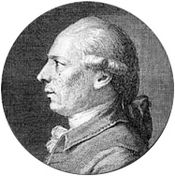 Philidor
PhilidorBetween 1200 and 1600 several laws emerged that drastically altered the game. Checkmate became a requirement to win; a player could not win by capturing all of the opponent's pieces. Stalemate was added, although the outcome has changed several times (see History of the stalemate rule). Pawns gained the option of moving two squares on their first move, and the en passant rule was a natural consequence of that new option. The king and rook acquired the right to castle (see Variations throughout history of castling for different versions of the rule).
Between 1475 and 1500 the queen and the bishop also acquired their current moves, which made them much stronger pieces (Davidson 1949:14-17). When all of these changes were accepted the game was in essentially its modern form (Davidson 1949:14-17).
The rules for pawn promotion have changed several times. As stated above, originally the pawn could only be promoted to the queen, which at that time was a weak piece. When the queen acquired its current move and became the most powerful piece, the pawn could then be promoted to a queen or a rook, bishop, or knight. In the 18th century rules allowed only the promotion to a piece already captured, e.g. the rules published in 1749 by François-André Danican Philidor. In the 19th century this restriction was lifted, which allowed for a player to have more than one queen, e.g. the 1828 rules by Jacob Sarratt (Davidson 1949:59-61).
Two new rules concerning draws were introduced, each of which have changed through the years:
Another group of new laws included (1) the touch-move rule and the accompanying "j'adoube/adjust" rule; (2) that White moves first (in 1889); (3) the orientation of the board; (4) the procedure if an illegal move was made; (5) the procedure if the king had been left in check for some moves; and (6) issues regarding the behavior of players and spectators. The Staunton chess set was introduced in 1849 and it became the standard style of pieces. The size of pieces and squares of the board was standardized (Hooper & Whyld 1992:220-21,laws, history of).
Until the middle of the 19th century, chess games were played without any time limit. In an 1834 match between Alexander McDonnell and Louis-Charles Mahé de La Bourdonnais, McDonnell took an inordinate amount of time to move, sometimes up to 1½ hours. In 1836 Pierre Charles Fournier de Saint-Amant suggested a time limit, but no action was taken. At the 1851 London tournament, Staunton blamed his loss in his match against Elijah Williams on Williams' slow play; one game was adjourned for the day after only 29 moves. The next year a match between Daniel Harrwitz and Johann Löwenthal used a limit of 20 minutes per move.The first use of a modern-style time limit was in an 1861 match between Adolph Anderssen and Ignác Kolisch (Sunnucks 1970:459).
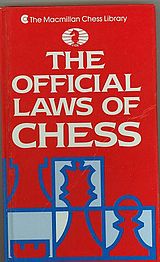

The first known publication of chess rules was in a book by Luis Ramírez de Lucena about 1497, shortly after the movement of the queen, bishop, and pawn were changed to their modern form (Just 2014). In the 16th and 17th centuries, there were differences of opinion concerning rules such as castling, pawn promotion, stalemate, and en passant. Some of these differences existed until the 19th century (Harkness 1967:3). Ruy López de Segura gave rules of chess in his 1561 book Libro de la invencion liberal y arte del juego del axedrez (Sunnucks 1970:294).
As chess clubs arose and tournaments became common, there was a need to formalize the rules. In 1749 Philidor (1726-1795) wrote a set of rules that were widely used, as well as rules by later writers such as the 1828 rules by Jacob Sarratt (1772-1819) and rules by George Walker (1803-1879). In the 19th century, many major clubs published their own rules, including The Hague in 1803, London in 1807, Paris in 1836, and St. Petersburg in 1854. In 1851 Howard Staunton (1810-1874) called for a "Constituent Assembly for Remodeling the Laws of Chess" and proposals by Tassilo von Heydebrand und der Lasa (1818-1889) were published in 1854. Staunton had published rules in Chess Player's Handbook in 1847, and his new proposals were published in 1860 in Chess Praxis; they were generally accepted in English-speaking countries. German-speaking countries usually used the writings of chess authority Johann Berger (1845-1933) or Handbuch des Schachspiels by Paul Rudolf von Bilguer (1815-1840), first published in 1843.
In 1924, Fédération Internationale des Échecs (FIDE) was formed and in 1929 it took up the task of standardizing the rules. At first FIDE tried to establish a universal set of rules, but translations to various languages differed slightly. Although FIDE rules were used for international competition under their control, some countries continued to use their own rules internally (Hooper & Whyld 1992:220-21). In 1952 FIDE created the Permanent Commission for the Rules of Chess (also known as the Rules Commission) and published a new edition of the rules. The third official edition of the laws was published in 1966. The first three editions of the rules were published in French, with that as the official version. In 1974 FIDE published the English version of the rules (which was based on an authorized 1955 translation). With that edition, English became the official language of the rules. Another edition was published in 1979. Throughout this time, ambiguities in the laws were handed by frequent interpretations that the Rules Commission published as supplements and amendments. In 1982 the Rules Commission rewrote the laws to incorporate the interpretations and amendments (FIDE 1989:7-8). In 1984 FIDE abandoned the idea of a universal set of laws, although FIDE rules are the standard for high-level play (Hooper & Whyld 1992:220-21). With the 1984 edition, FIDE implemented a four-year moratorium between changes to the rules. Other editions were issued in 1988 and 1992 (FIDE 1989:5), (Just 2014).
The rules of national FIDE affiliates (such as the United States Chess Federation, or USCF) are based on the FIDE rules, with slight variations (Just 2014). Kenneth Harkness published popular rulebooks in the United States starting in 1956, and the USCF continues to publish rulebooks for use in tournaments it sanctions.
In 2008 FIDE added the variant Chess960 to the appendix of the laws of chess. Chess960 uses a random initial set-up of main pieces, with the conditions that the king is placed somewhere between the two rooks, and bishops on opposite-color squares. The castling rules are extended to cover all these positions.
One case of a minor extra rule being added for a particular match is "no drawing or resigning during the first 30 moves" in the London Chess Classic on 8-15 December 2009 at Olympia, London.